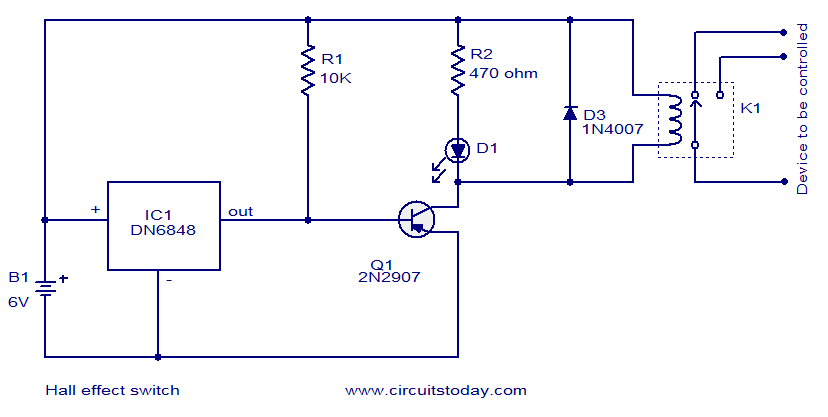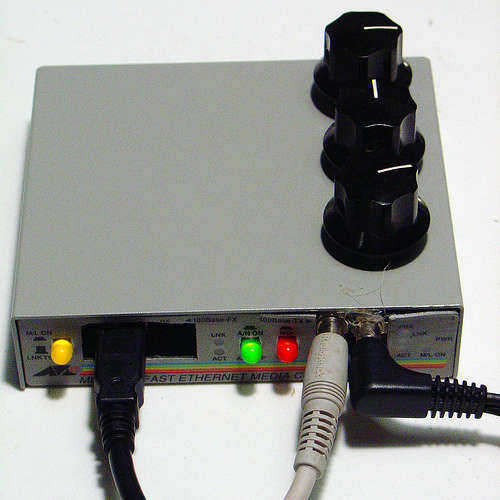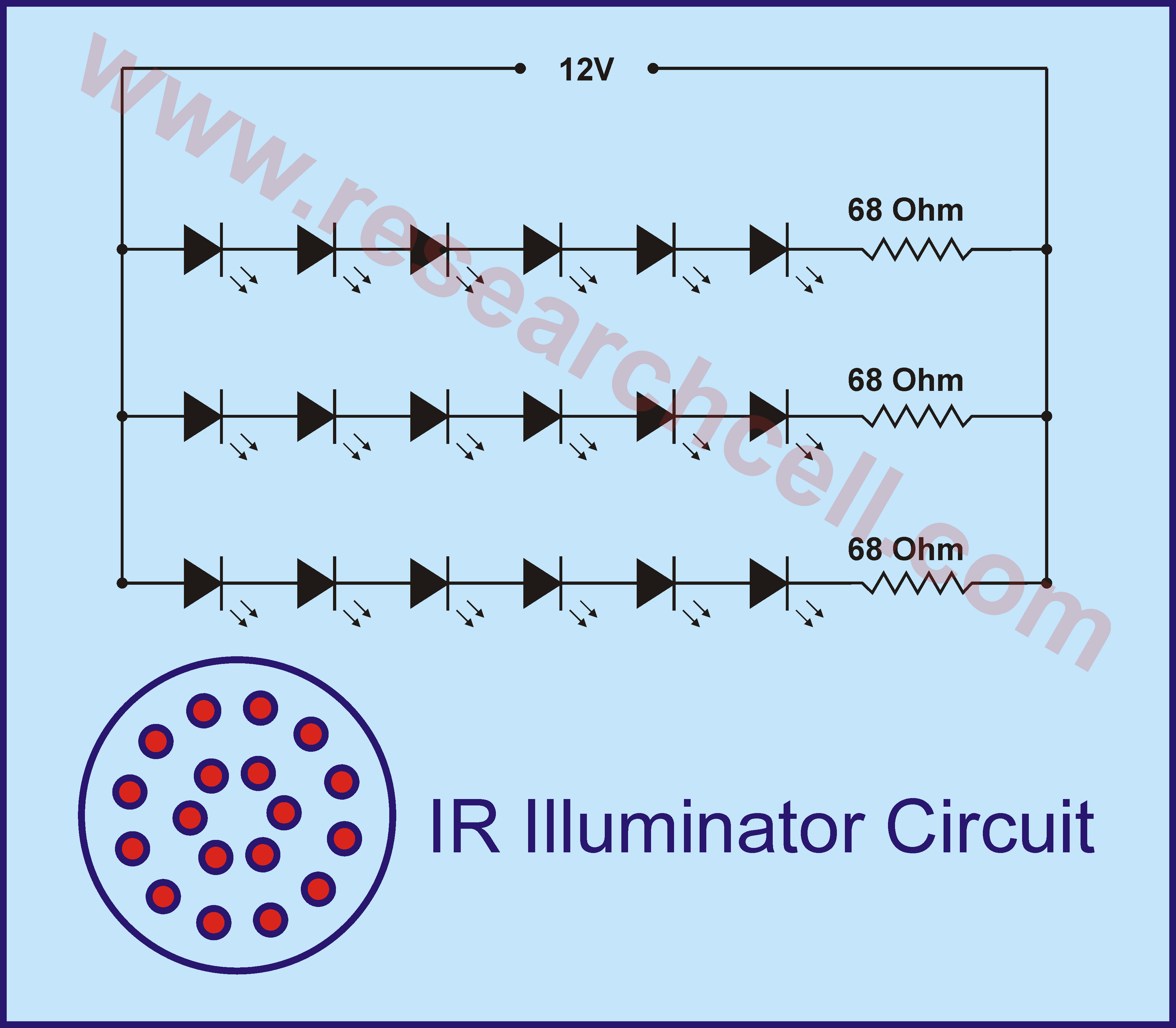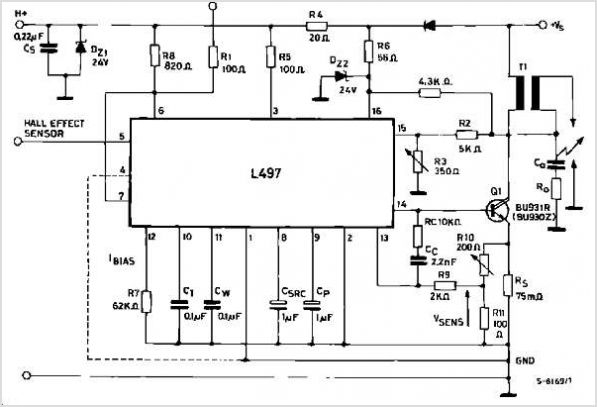
DIY Tremolo Effect
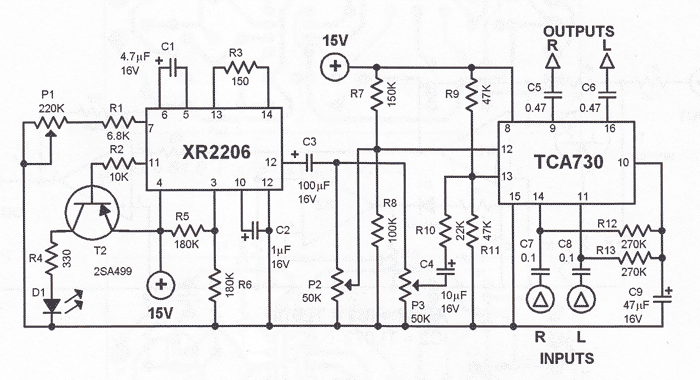
This tremolo effect circuit utilizes the XR2206 and TCA730 integrated circuits (ICs), designed for electronic balancing and volume regulation with frequency correction. The circuit is suitable for stereo channels and can simulate the Lesley effect, also known as the rotating loudspeaker effect. Balance and volume adjustments are made using a linear potentiometer for both channels. If this potentiometer is replaced with an AC voltage source, periodic modulation of the input signal can be achieved. This AC voltage source is derived from the function generator IC XR2206, which produces square, triangle, and sine wave signals; however, only the sine wave is utilized in this project. The modulation frequency can be varied using potentiometer P1, ranging from 1 Hz to 25 Hz. Resistor R3 determines the operating level of the sine wave generator, while resistors R5 and R6 set the DC voltage and sine wave amplitude at the output. Capacitor C2 acts as a ripple filter. The square wave output from the XR2206 drives transistor T2 and an LED, providing optical frequency indication. The modulating voltage is sent to pin 13 of the TCA730 through potentiometer P3 and resistor R10, functioning as volume control or volume modulation. The extent of the balance modulation, contributing to the Lesley effect, can be adjusted with potentiometer P2. A regulated power supply using the 7815 IC is recommended to prevent current variations that could adversely affect modulation.
This tremolo effect circuit is designed to provide a versatile modulation effect suitable for audio applications, particularly in stereo setups. The XR2206 function generator is central to generating the modulation waveforms, specifically the sine wave, which is essential for achieving the desired audio effects. The modulation frequency, adjustable via P1, allows for fine-tuning of the tremolo effect, accommodating various musical styles and preferences.
The resistors R5 and R6 play a critical role in defining the output characteristics, specifically influencing the amplitude and DC offset of the modulation signal. Capacitor C2 serves to smooth out any ripple in the output, ensuring a clean signal is fed into the subsequent stages of the circuit. The combination of the square wave output and the LED indicator provides visual feedback, allowing users to monitor the modulation frequency easily.
The TCA730 IC, known for its volume control capabilities, is effectively utilized here, with pin 13 receiving the modulating voltage to create a dynamic volume modulation effect. This integration allows for the simulation of the Lesley effect, where the sound appears to swirl and move, reminiscent of a rotating speaker cabinet. The adjustment of P2 provides further control over the intensity of this effect, enabling users to customize their sound.
Finally, the recommendation for a regulated power supply, such as the 7815 IC, underscores the importance of stable voltage in audio circuits. Variations in power supply can lead to inconsistent modulation results, which would detract from the overall performance of the tremolo effect circuit. This design emphasizes the importance of careful component selection and configuration to achieve a professional-quality audio effect.This tremolo effect circuit uses the XR2206 and the TCA730 IC which is designed as an electronic balance and volume regulator with frequency correction. The circuit is use full for stereo channels and it also has the ability to simulate the Lesley effect aka rotating loudspeaker effect.
Balance and volume settings are done with a linear potentiome ter for both channels. If this potentiometer is replaced with an AC voltage source, a periodic modulation of the input signal can be achieved. This AC voltage source comes from the function generator IC XR2206. This IC generates square, triangle and sine wave signals but for this project we use only the sine wave.
The modulation voltage can be varied with P1 from 1 Hz up to 25 Hz. Resistor R3 sets the operation level of the sine wave generator. R5 and R6 set the DC voltage and the sine wave amplitude at the output. C2 is a ripple filter. The square wave output of the XR2206 drives T2 and a LED to optically display the frequency. The modulating voltage reaches pin 13 of TCA730 via P3 and R10. This input functions as the volume control or in this case the volume modulation. The degree of the balance modulation (Lesley effect) can be varied with P2. A regulated power supply using 7815 IC is recommended. Do not use a non-stabilized power supply since the current variations would influence the modulation negatively. 🔗 External reference
This tremolo effect circuit is designed to provide a versatile modulation effect suitable for audio applications, particularly in stereo setups. The XR2206 function generator is central to generating the modulation waveforms, specifically the sine wave, which is essential for achieving the desired audio effects. The modulation frequency, adjustable via P1, allows for fine-tuning of the tremolo effect, accommodating various musical styles and preferences.
The resistors R5 and R6 play a critical role in defining the output characteristics, specifically influencing the amplitude and DC offset of the modulation signal. Capacitor C2 serves to smooth out any ripple in the output, ensuring a clean signal is fed into the subsequent stages of the circuit. The combination of the square wave output and the LED indicator provides visual feedback, allowing users to monitor the modulation frequency easily.
The TCA730 IC, known for its volume control capabilities, is effectively utilized here, with pin 13 receiving the modulating voltage to create a dynamic volume modulation effect. This integration allows for the simulation of the Lesley effect, where the sound appears to swirl and move, reminiscent of a rotating speaker cabinet. The adjustment of P2 provides further control over the intensity of this effect, enabling users to customize their sound.
Finally, the recommendation for a regulated power supply, such as the 7815 IC, underscores the importance of stable voltage in audio circuits. Variations in power supply can lead to inconsistent modulation results, which would detract from the overall performance of the tremolo effect circuit. This design emphasizes the importance of careful component selection and configuration to achieve a professional-quality audio effect.This tremolo effect circuit uses the XR2206 and the TCA730 IC which is designed as an electronic balance and volume regulator with frequency correction. The circuit is use full for stereo channels and it also has the ability to simulate the Lesley effect aka rotating loudspeaker effect.
Balance and volume settings are done with a linear potentiome ter for both channels. If this potentiometer is replaced with an AC voltage source, a periodic modulation of the input signal can be achieved. This AC voltage source comes from the function generator IC XR2206. This IC generates square, triangle and sine wave signals but for this project we use only the sine wave.
The modulation voltage can be varied with P1 from 1 Hz up to 25 Hz. Resistor R3 sets the operation level of the sine wave generator. R5 and R6 set the DC voltage and the sine wave amplitude at the output. C2 is a ripple filter. The square wave output of the XR2206 drives T2 and a LED to optically display the frequency. The modulating voltage reaches pin 13 of TCA730 via P3 and R10. This input functions as the volume control or in this case the volume modulation. The degree of the balance modulation (Lesley effect) can be varied with P2. A regulated power supply using 7815 IC is recommended. Do not use a non-stabilized power supply since the current variations would influence the modulation negatively. 🔗 External reference
